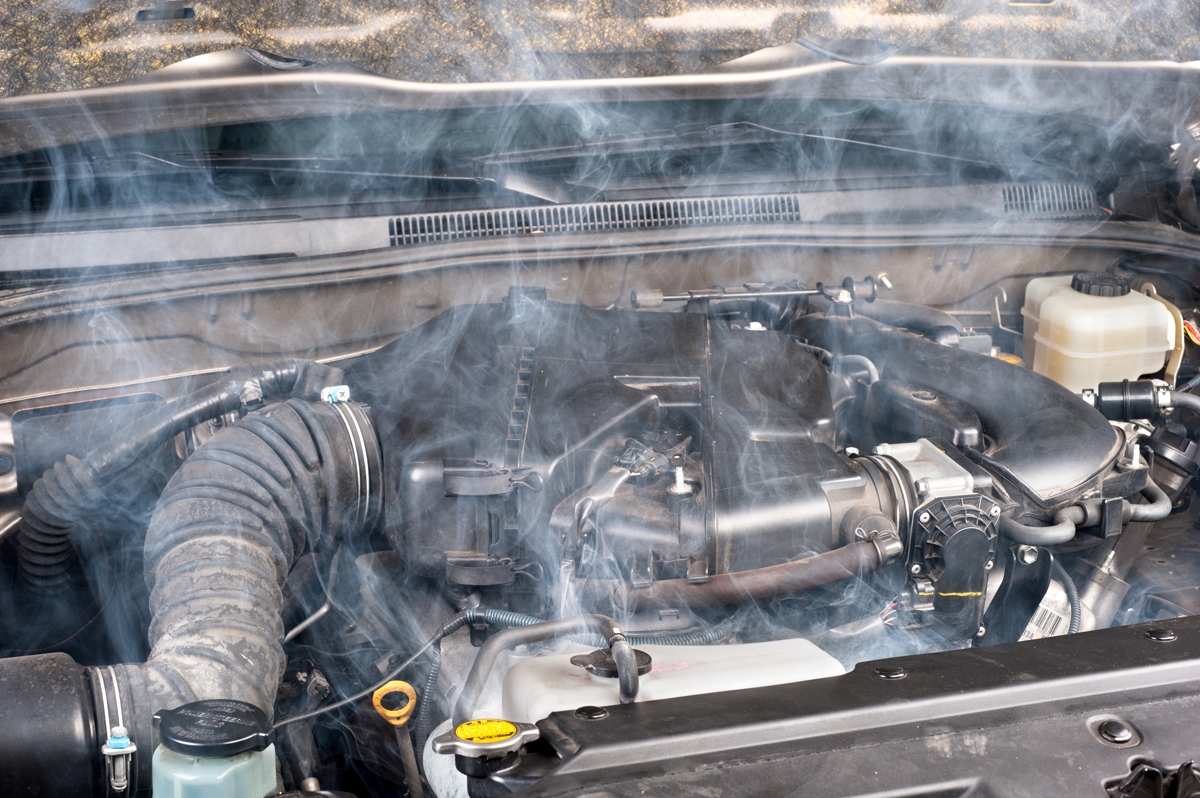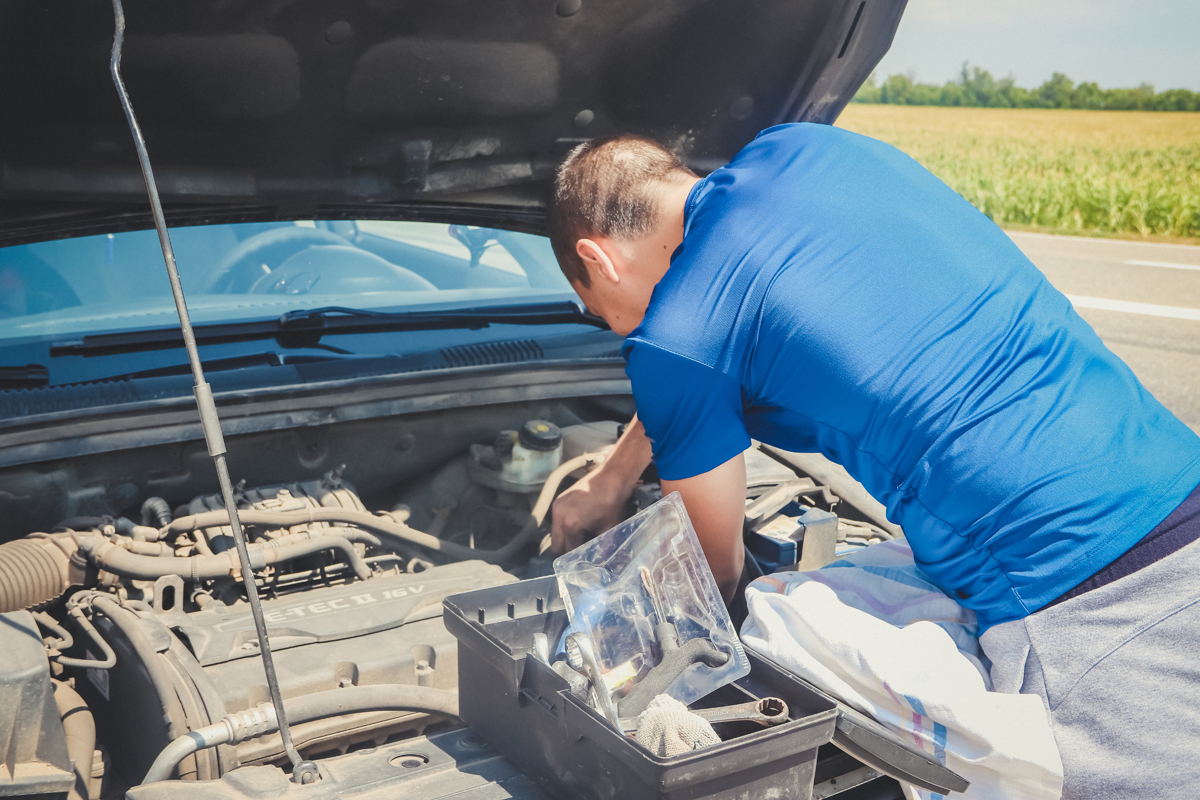
No driver wants to deal with a vehicle overheating, but if you catch the issue fast enough you could save the vehicle from undergoing major repairs. This article will give the signs of vehicle overheating and the necessary steps toward fixing the problem.
Overheating Car Symptoms
If you try to check the coolant level of your engine as soon as you notice overheating, it could result in some serious burns. Let your engine cool down before giving it a look and always watch out for these signs below, signaling that the vehicle is too hot.
1. The Car Smells Hot
Most people describe the combined smell of plastic, rubber gaskets and seals and residual motor oil as smelling hot. This can happen even if your gauge is stating that it is in its normal level and the warning light does not appear. This “hot” odor can come through the AC vents because the engine is located close to the HVAC system’s fresh air intake.
2. Temperature Light Or Gauge
Every car has a temperature gauge or warning light that comes on to notify you of the temperature engine. When the warning light appears, it means the engine currently exceeds its normal operating temperature. The only downside with these devices is that they can malfunction due to coolant leaks.
3. Engine Has A Ticking Sound
Engine oil is used to lubricate and provide layers of protection between several moving parts within the vehicle. The oil loses its ability to provide the layers whenever it gets overheated. When this occurs, the clearances in the engine begin to tick, indicating the lubrication process has failed.
4. Thumping Sounds
When an engine goes cold, it will not work properly. This is why the engine has a thermostat, but the problem with this device is when it fails to open it can cause the coolant to overheat inside the engine. This can result in a thumping noise coming from the engine. The sound is an indicator that your thermostat needs to be replaced altogether.
5. Steam Coming From The Hood
This is one of the more obvious signs of an overheating vehicle. Whenever there is boiling coolant, it will cause steam to be generated from either the front, rear or sides of the hood. This is due to the coolant going past the boiling point and becoming steam. The engine needs to be shut off immediately whenever steam is noticed.
6. Coolant On The Ground
Another indication of overheating is when you find any amount of coolant on the ground underneath your car. Coolant appearing on the ground after the vehicle is parked can mean one of two things: the cooling system has a leak or coolant has boiled inside the cooling system.
7. Hood Is Hot
Your hood is undoubtedly hotter than any other area of the car, but it should not be extremely hot to the touch. In a worst-case scenario, you should be able to at least keep your hand on the hood for 10 seconds. If you are unable to touch the hood due to temperature, then it should be looked at by the professionals.
8. Reduced Engine Power
An overheating engine may cause reduced power due to the slowing down of the crankshaft rotation. Once it slows down, the amount of power the engine produces is limited. If your vehicle is having trouble keeping up with traffic, check the temperature gauge or light to see if there is a temperature issue in the engine.
What To Do When A Car Is Overheating
The first step is pulling over once you see that the vehicle is overheating. It goes without saying that serious damage can be done to your vehicle during this situation, so follow our steps to safety below.
1. Pull Over Safely
The first rule is to stay calm when you notice your car overheating. Pulling over quickly and turning off the engine will allow the engine to start cooling down immediately. This can prevent further damage to the engine when the vehicle is shut off promptly. If you are unable to pull over, turn off the vehicle’s AC and lower your windows. Turning the heater up all the way will help cool the engine. Put your hazards on and drive slowly, proceeding with caution.
2. Check Under Hood
Wait until any steam or smoke stops pouring out before lifting the hood up. Touch the hood quickly and if it is still hot, refraining from opening it. Shut the car off, but leave the key in the on position at this time. Wait at least 30 minutes before attempting to touch the engine or radiator cap. Run the fans with the engine off and key in the on position to avoid serious burns.
3. Check If The System Is Pressurized
You can do this by checking the radiator hose, which is found in the upper side of the engine. The radiator hose is likely hot so use a towel or rag to squeeze it. A stiff feeling means there is still pressure in the system. The cap should not be removed until pressure has subsided.
4. Wait Before Removing Radiator Cap
Safety is key when tasked with removing the radiator cap, as this can lead to serious burns. Pressure coolant can spray out and cause harm. Remember, coolant of an overheated engine can exceed 250 degrees F. As soon as pressure is released and exposed to air, it can boil extremely fast. Use your rag or towel to remove the cap. Some may require you to push down after being loosened while others will simply screw off counter clockwise.
5. Check Coolant Level
The radiator cap will be attached to a white tank, which contains the coolant. Give the vehicle about 40 minutes to cool down before you check the coolant level by removing the cap. There will be a level to indicate how high to refill your coolant.
6. Check For Coolant Leaks
Look under the car for any leakage. Newer vehicles feature various coolant colors, while it will always appear green in older models. It is easy to tell the difference between an oil and coolant leak. Oil is much thicker, while coolant is sweet to the smell.
7. Refill Engine Coolant
Before pouring coolant slowly into the radiator, wait for the vehicle to cool completely. Must are designed to run on diluted coolant so having water nearby is convenient. Dilute the coolant to about a 50/50 split between coolant and water, if possible. It is possible to use just water as short-term solution. This will work, but it will not be permanent.
8. Monitor Engine Condition
You can test the engine after refilling it with coolant. Turn it to the on position and carefully monitor the temperature gauge. If it races towards hot again, shut the car off. Try again after another 20 minutes or so.
9. Take Car To Repair Shop
If you simply cannot cool the engine down yourself, it is suggested to call for a tow truck. A typical engine replacement costs about 15% of the vehicle’s total value.
What Causes A Car To Overheat?
Of course, the most common reason for a car overheating is when the coolant level is low. When the level is low, it causes the heat that is inside of the engine to stay in while creating steam as the temperature inside rises. A leak in the engine is the most common cause of the low amount of coolant. Additional reasons can include a cooling fan failing to work or a blown head gasket.
Rov-N-Techs In Scottsdale, Arizona
Rov-N-Techs performs all factory recommended services on Land Rovers & Jaguars at affordable prices! Master Technicians, Joe Caraway and Kevin Curtis worked at Land Rover of North Scottsdale for 10 years before opening their own shop in 2006 under the name of “Rover Techs”. Now known as “Rov-N-Techs” Joe and Kevin offer over 35 years of combined Land Rover experience. Contact us today!




